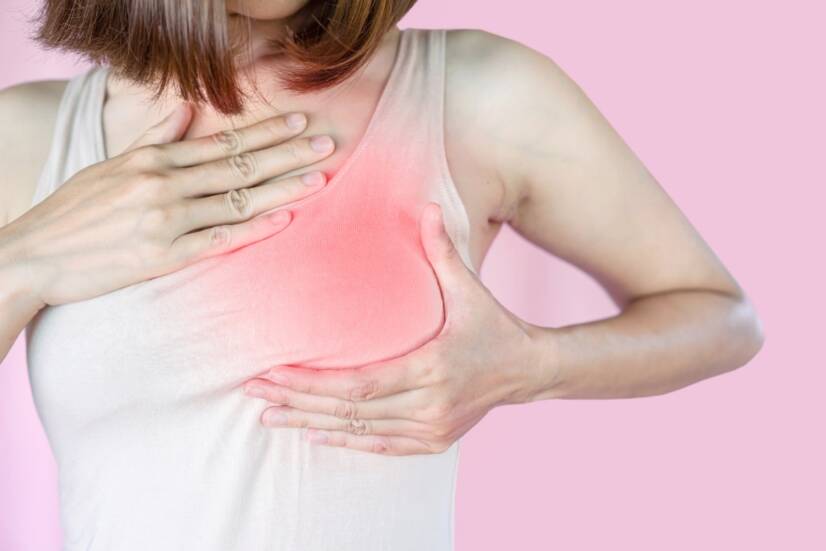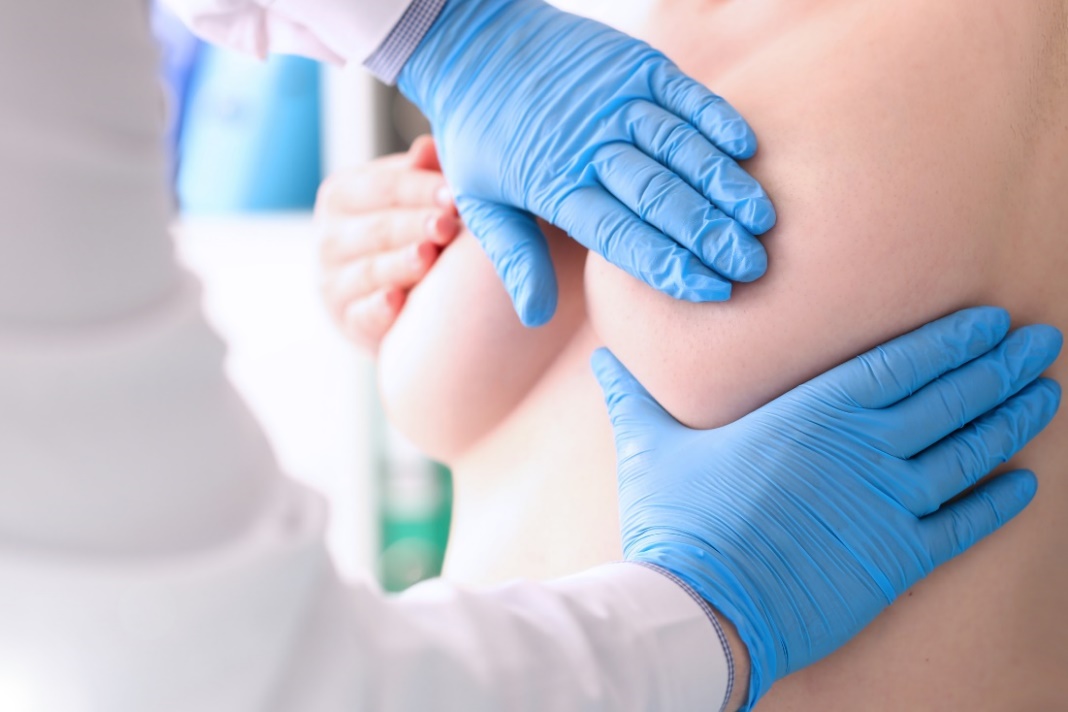- ROZTOČIL, Aleš and Pavel BARTOŠ. Modern Gynaecology. Prague: Grada, 2011. ISBN 978-80-247-2832-2
- pubmed.ncbi.nlm.nih.gov - Evaluation and management of breast pain. Robin L Smith, Sandhya Pruthi, Lorraine A Fitzpatrick
- medicalnewstoday.com - Everything you need to know about itchy nipples. Lori Smith, MSN, BSN, WHNP-BC
- healthline.com - Why Are My Nipples Itchy? Healthline. Rachel Nall, MSN, CRNA and Crystal Raypole
Itching and nipple pain: what are all the possible causes?

Photo source: Getty images
However, if it lasts for a long time, is non-specific or turns into pain, it is advisable to contact a doctor to find out the cause.
Article content
The causes of itching and pain around the nipples are varied. From an allergic reaction to a cosmetic product, through hormonal changes in the cycle to more serious breast disease. What are all the causes, treatment options and other interesting information you will learn in the article.
Breast nipples in a nutshell
The mammary nipple (technically papilla mammae) is a mammalian skin formation located in the middle of the pigmented mammary areola (areola mammae).
The nipple, together with the mammary areola, forms the outlet of the mammary gland, the milk duct. It is conical in shape for sucking breast milk. In women, the nipple is used to nurse (feed) the newborn during lactation.
The nipple may show various pathological changes and disorders. Pathological manifestations of the nipple are itching, burning, change in texture, change in pigmentation, pain or non-specific discharge from the nipple.
Causes of nipple itching and pain
The aetiology of the unpleasant sensation around the nipples varies. In many cases, it is not related to anything serious and is the result of an external factor such as an allergic reaction to cosmetics, incorrect choice of bra, physical activity or cyclic hormonal changes.
However, the nipple area can also be affected by breast disease, either benign (non-malignant) or malignant in nature. It can also be a skin disease falling under the field of dermatovenerology.
In the case of a long-standing, non-specific or vague problem around the nipples, it is advisable to consult a doctor to determine the exact cause and rule out breast disease.
The most common factors of nipple itching/pain:
- Allergic skin reaction to the product
- Inappropriate cleanser
- Inappropriate bra material
- Hormonal changes in the cycle
- Skin diseases (eczema, dermatitis...)
- Period of pregnancy
- Period of breastfeeding and lactation
- Non-malignant breast disease
- Malignant breast disease
Allergic reaction to a cosmetic product
Irritation of the skin with an inappropriate substance can cause itching and possibly mild burning of the nipples and nipple area. The most common reason for an allergic reaction is inappropriately chosen cosmetic products - shower gels, soaps, body washes, etc.
Some cosmetic products contain irritants and perfumed substances that can contribute to skin problems, especially in women with overly sensitive skin.
However, sometimes inappropriately chosen detergents and fabric softeners can cause itching of the breasts and nipples. In addition, if you sweat in the breast area, skin irritation can be even more pronounced.
An allergic skin reaction to an unsuitable product results in red skin that itches and sometimes itches or burns.
If this could be the cause of discomfort around the nipples, it is advisable to change the cosmetic and washing product.
It is advisable to use hypoallergenic, unscented products or natural products for sensitive skin.
Inappropriate bra and clothing
The first factor in choosing the right bra is the material. Underwear made from too many synthetic fibres can cause an unpleasant skin reaction - itching and scratching in the breast and nipple area.
Along with sweating in the breast area, the discomfort is amplified.
The second factor in choosing the right bra is bra size. If the bra is too tight, small or push-up, there is a long-term increased pressure on the breast area.
This can result in uncomfortable tightness and mild breast pain. In conjunction with unsuitable material, women's underwear can cause unwanted skin reactions.
It is advisable to reach for bras made of more natural, airy materials that are pleasant to the touch.
Together with the right choice of the right size, it is possible to eliminate discomfort in the breast and nipple area.
Skin diseases
Another possible cause of itching of the nipples or the breasts themselves is a skin condition. Dermatitis, eczema, psoriasis and many other skin conditions can manifest themselves in the chest, breasts and around the nipples.
Skin diseases are often manifested by, among other things, the appearance of various spots, dryness, redness, rashes, changes in pigmentation or peeling of the skin.
When similar symptoms occur, it is advisable to seek the professional help of a dermatologist, a dermatovenerologist who will pinpoint the disease and adjust the treatment. In most cases, this involves topical pharmacological treatment in the form of creams, ointments and hygiene regimes.
Hormonal changes in the female cycle
During the menstrual cycle, there is an alternating rise and fall in the level of sex hormones (estrogen, progesterone, prolactin...).
Before menstruation and at the beginning of menstruation, PMS - premenstrual syndrome- occurs as a result of a drop in hormones. As part of the physical manifestations of PMS, increased tension and tenderness in the breasts can be felt.
In some cases, it is also possible to feel a slight itching around the nipples. A similar condition can also occur during fertile days and the period of ovulation.
If a woman's cycle stops working in view of older age and the menopause period, a woman may experience various physical and psychological changes. Sudden hot flashes, headaches, fatigue, insomnia and more.
The loss of hormones also causes the function of the mammary gland to disappear. The mammary gland is gradually replaced by fat. Thus, increased breast tenderness and mild breast tenderness or atrophic changes of the mammary gland may also occur.
Pregnancy and breastfeeding
In addition to hormonal changes, pregnancy also causes an increase in breast volume. During lactation and preparation of the breast tissue for milk production and breastfeeding, mild itching and increased sensitivity of the nipples or the breasts themselves may be experienced.
Breastfeeding may be accompanied by nipple itching due to nipple distortion, cracking or bleeding.
Nipple itching during breastfeeding is mainly caused by milk residues in the milk ducts, blocked milk ducts due to thick breast milk or an inflammatory process in the breast tissue itself. A visit to a gynaecologist is always necessary.
During breastfeeding, itching can also be caused by yeast infections that can develop on the nipples. Therefore, thorough breast hygiene before and after breastfeeding is important.
In case of ambiguity and non-specific symptoms, it is always necessary to seek professional help from a gynaecologist.
Non-malignant (benign) breast disease
During the course of her life, a woman may feel a lump or a hardened part in her breast. In most cases, this is a benign benign formation of the breast tissue. It may be a cyst, papilloma, lipoma, fibroadenoma or an abscess in the breast tissue.
The presence of a lump may be associated with pain and tenderness in the breast and nipple area. The presence of a pathological bloody discharge from the nipple is also possible in the disease.
Due to the painfulness and possible occurrence of a wide range of breast tissue formations, diagnosis by a specialist gynaecologist is necessary.
Malignant breast disease
Pain in the breast tissue and nipples is one of the possible signs of breast cancer.
However, it is not the only symptom. There are usually other symptoms of cancer - the presence of lumps, enlarged lymph nodes in the armpits, increased fatigue, weight loss and many others.
Breast cancer is a common cause of death among cancers in women. However, if the disease is diagnosed at an early stage, there is a good prognosis and a possible chance of a complete cure.
The basis of breast cancer prevention is regular self-examination of the breast at home and regular preventive check-ups with a gynaecologist.
Diagnosis and treatment options for nipple changes
Diagnosis of breast changes is based on a specialist examination by a gynaecologist. In the case of skin disease, on the basis of an examination by a dermatovenerologist.
The dermatovenereologist examines the affected area by examining the aspects through a special magnifying glass. He makes an accurate diagnosis and determines the form of treatment. This usually includes local pharmacological treatment and modification of the hygienic lifestyle.
As part of the breast diagnosis, the gynaecologist examines the breast tissue by sight (inspection) and palpation. The doctor takes a medical history and discusses the symptoms with the patient.
In most cases, he or she will use surface ultrasound (ultrasonography) to get a more thorough view of the internal soft structures of a woman's breast tissue.
If there is any ambiguity, the gynaecologist may prescribe further ultrasound or mammography of the breasts. He or she may also perform a palpation examination per vaginam as in a routine preventive examination.
Treatment options for itching and nipple pain depend entirely on the diagnosis made.
Once the doctor has identified the cause, treatment can be initiated. This ranges from lifestyle modification, hygiene measures, choice of appropriate bra and clothing, pharmacological treatment of skin disease to monitoring and specific treatment of benign or malignant breast tissue formations.
The basis of breast health prevention is home self-examination, regular professional examination by a gynaecologist and an urgent visit to the doctor when a specific non-specific breast change or pain is detected.

Itching and nipple pain in men
This symptom is less common in the male gender, but men can also experience discomfort in the nipple and breast area.
This may be an allergic skin reaction to a cosmetic product or inappropriate clothing material in conjunction with physical activity and sweating.
In some cases, it may be an allergic reaction or a skin disease that manifests itself as itching (dermatitis, eczema, etc.). Professional examination and treatment by a dermatovenereologist is necessary.
Gynecomastia is one of the problems that men may encounter in connection with the hormonal system.
This is a problem with the male mammary gland that can arise due to an excess of female hormones. The manifestation is swelling of the breast tissue, but also increased sensitivity of the breasts and nipple area.
The most serious rare cause of pain and changes in the breast and nipple area is malignancy. Malignancy can be accompanied by a number of other symptoms such as the presence of a lump, thickened breast tissue, fatigue, weakness and many others.
In case of any confusion and changes, it is necessary to see a doctor for professional help.
Interesting resources
Related

Mgr. Kristína Krajčovičová
Healthcare worker
I completed my bachelor's degree in physiotherapy at the Faculty of Biomedical Engineering of the Czech Technical University in Prague. I continued and completed my master's degree in physiotherapy at the Faculty of Health Engineering of TnUAD. I am currently pursuing my PhD rigorosis at the Slovak University of Health Sciences in Bratislava. During my studies I worked as a physiotherapist in the rehabilitation clinic of Vamed Mediterra in Prague and then as a physiotherapist at the Regional Hospital in Liberec in the Department of Neurology. During my employment I was part of the medical team in the Covid19 department. I am mostly interested in human musculoskeletal system, rehabilitation, physiotherapy in gynaecology and natural medicine. My hobbies include exercising, running, writing and managing social media.
View all articles by the same authorThe aim of the portal and content is not to replace professional
examination. The content is for informational and non-binding purposes
only, not advisory. In case of health problems, we recommend seeking
professional help, visiting or contacting a doctor or pharmacist.









